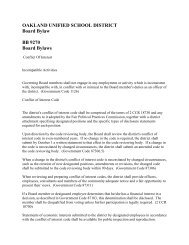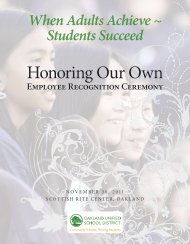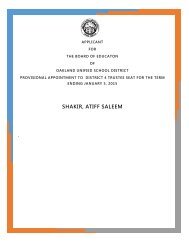Oakland Unified School District Case Study
Oakland Unified School District Case Study
Oakland Unified School District Case Study
You also want an ePaper? Increase the reach of your titles
YUMPU automatically turns print PDFs into web optimized ePapers that Google loves.
elentless attention to college readiness,<br />
public celebrations of academic achievement,<br />
and strong parent-community relationships.<br />
All students are expected to leave AWE<br />
with the skills and determination to successfully<br />
pursue a college education, and it<br />
is apparent that AWE staff members have<br />
worked diligently to use meaningful symbols<br />
and events to create a school climate<br />
focused on achieving this goal. For example,<br />
the staff make it a point to refer to<br />
their students as “scholars.” These scholars<br />
attend classes named after universities and<br />
constantly celebrate their academic achievements.<br />
The hallways are filled with examples<br />
of student work and pictures of students<br />
who have achieved high levels or who<br />
have made significant progress in improving<br />
their scores on the school’s interim assessments<br />
in math and language arts.<br />
Public celebration of academic success is<br />
also the focal point of the school’s culture:<br />
AWE builds its academic learning climate<br />
by regularly convening members of the<br />
school community to recognize academic<br />
success in the weekly culture assembly.<br />
During one assembly, students, dressed in<br />
their school uniforms, gathered outside in<br />
the amphitheatre for announcements and<br />
recognition of academic success. The principal,<br />
teachers, and the school’s student<br />
leadership team led the assembly. With<br />
many parents in attendance, the assembly is<br />
an on-going opportunity to involve parents<br />
in the culture of the school. Most of the assembly<br />
time was spent recognizing students<br />
who met the school’s standards for proficiency<br />
or growth.<br />
Students receive certificates for learning<br />
growth and medals for meeting or exceeding<br />
the learning benchmark score. Principal<br />
Kean explains the reason for differentiating<br />
the awards — certificates for growth, and<br />
medals for proficiency. “We want to recognize<br />
growth, but we don’t want to confuse<br />
it with meeting the standard.” Students<br />
are well behaved and take great pride in<br />
their awards, as many run off to show their<br />
parents their medals at the conclusion of<br />
the assembly. The culture assembly also<br />
provides a measure of transparency and<br />
accountability for teachers. A teacher commented<br />
that:<br />
We give awards for growth, and<br />
we’re going to look at the results, but<br />
try not to take it personally. We don’t<br />
all have the same kids. It’s been hard.<br />
Each time I’ve had a lot of kids [recognized]<br />
and the other class hasn’t.<br />
I’m at 80% and they’re at 20%, and<br />
the kids say ‘I’m glad I’m not in that<br />
class.’ They don’t necessarily see that<br />
the teacher was out and then came<br />
back. It does put pressure on [teachers].<br />
It’s a double-edged thing. We<br />
need to acknowledge and reward<br />
change and movement forward, but<br />
it’s still a hard one.<br />
Although the culture assemblies may<br />
cause tensions that teachers must navigate<br />
daily, it is clear that these practices foster<br />
a sense of academic purpose and identity<br />
for the majority of the students. As one<br />
fifth grader said, “The students at ACORN<br />
don’t fool around as much as the students<br />
at other schools, [and] the teachers have<br />
high expectations to do their work.” Other<br />
students have a similar perspective, as they<br />
described the school as “good,” “aspiring,”<br />
and “fantabulous.”<br />
In addition to a clear focus on college<br />
readiness, the school has also improved its<br />
climate by taking advantage of its small<br />
8<br />
<strong>School</strong> Redesign Network at Stanford University
















